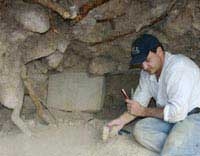Researchers Discover Evidence of a Factory Specializing in Rubber Band Ammunition from 7,200 Years Ago
The oldest known war weapon manufacturing plant may have been established in the early Bronze Age in what is now Israel, according to a report by IFL Science on November 23. Based on the analysis of hundreds of stone projectiles collected from two archaeological sites, researchers concluded that they were mass-produced, revealing a well-equipped preparation for soldiers ready for battle approximately 7,200 years ago.

Uniformly shaped and sized projectiles. (Photo: Israel Antiquities Authority)
The archaeological team examined 424 sling stones at the ancient settlements of ‘En Esur and ‘En Zippori, which were inhabited around 5,800 to 4,500 BCE. Observing that the stones were nearly identical, the researchers determined they were crafted to specific standards, with an average length of 52mm, width of 31mm, and weight of 60g.
The stones used as rubber band ammunition are very smooth with a slightly pointed aerodynamic shape at both ends, allowing for accurate and effective shooting, according to the Israel Antiquities Authority. In a related study published in the journal ‘Atiqot, scientists explained that the pointed design is believed to be optimal for slingshot ammunition, later adopted by both the Greek and Roman armies.
In fact, these stones represent the earliest evidence of warfare in the Southern Levant. The similarity in their shape indicates a large-scale industrial production process. The uniformity in weight, shape, and size of the sling stones suggests they were systematically produced for soldiers to use with standard slings, enabling effective training.
Contextualizing the discovery in historical terms, the research authors noted a clear transition from ordinary sling stones (like natural pebbles) to high-standard weaponry, which may reveal the development of organized warfare in the early Bronze Age. This possibility is further heightened by the increased settlement scale in the Southern Levant at that time.
Sling stones are often found clustered together, providing evidence of how they were used. According to researchers, this arrangement indicates that the projectiles were fired en masse at the same time by a group of shooters. In warfare, this could disrupt enemy formations. Interestingly, such mass-produced weapons suddenly disappeared from the archaeological record about a millennium later, although researchers are unclear whether this indicates a decline in conflict in the region.





















































